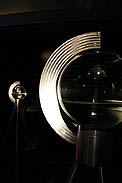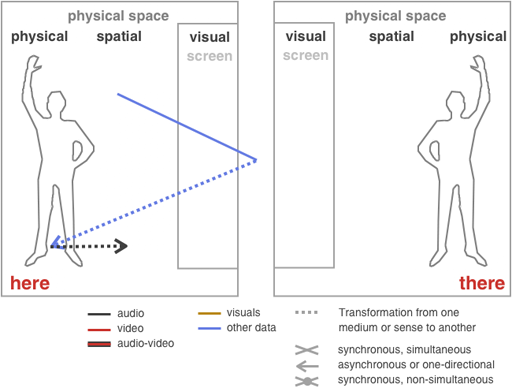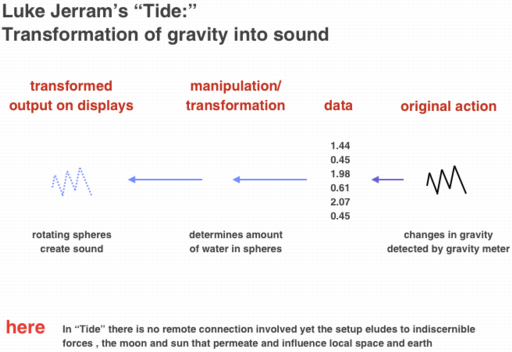Luke Jerram, "Tide," 2001Luke Jerram is an artist based in Bristol with a history of original, imaginative and poetic projects1. His installation “Tide”2 alludes to the influence of the moon and the fourteen metres difference of altitude at the height of tide in the English town of Bristol. “Tide” transforms changes of gravity, respectively of the moon, into a resonating immersive visual and aural experience. |
 Image: Sandra Fauconnier |
||
Here and there, telematic aspectsThe telematic aspect of the piece is somewhat ambiguous as there is no connection through a distinct channel to a remote place. It is about the here and now, and the indiscernible influence of celestial objects upon the natural surroundings. A related project, Ken Goldberg's “Mori” is solely about the Here, this particular ground beneath our feet - "Tide"also alludes to the moon above us, the music of the spheres, of the moon and the sun. While "Mori" transforms indiscernible motions of the earth into a visual and musical experience, it aims at making us question the ground beneath our feet. An experience which some may find unsettling or disconcerting. Goldberg also has the intention to make visitors question the validity of the information they experience and also the accuracy of his instruments . Can we trust our senses? How can we trust these remote sensors, far away? A challenging play with our perception and the illusion of safety3. Luke Jerram's "Tide" is mainly about the moon out there and only secondly about the earth, influenced by the moon. These influences follow a circular, predicable rhythm, ebb tide and high tide. A rhythm that imbues many natural cycles on earth and from which the word "months" has originated. So "Tide" is less an uncanny statement about the accuracy of our instruments vs. the infallibility of our senses or the fragile permanence of our world, than an imaginative, immersive and spatial sound experience that transforms "the macrocosm" to a graspable, humane microcosmic scale. Similar to the visitor encompassing the space between the sounding spheres, their macrocosmic counterparts moon and earth encompass' the space of our solar system. This sonic space alluding to Kepler's "sound of the spheres" resonates around the visitors and unfolds its immersive quality, interconnecting them with the celestial objects that are usually beyond reach. |
|||
Transformation & Spatiality in TideAlthough there is a curve projected against the wall as a visual aid, the installation is primarily a visceral, immersive and spatial experience. There is no transportation involved, "Tide" is about the here and now; only alluding to indiscernible forces of the moon and sun. 
|
|||
|
In "Tide" there is no remote connection involved, yet the setup eludes to indiscernible forces, the moon and the sun, that permeate and influence local space and earth from far away. Transformation, multimodal mappingThe transformative aspect takes place in two dimensions; As the visual and abstract 24 hour curve that is projected upon the wall, and as the physical spheres themselves with their technical appearance and source of the sound. By listening to the sound of the spheres and understanding the way they work, visitors experience the live transformation of the indiscernible gravimeter code into permeating and intermingling layers of harmonic overtones resulting in a visceral physical experience of cosmic dimension. 
|
|||
Conclusion"Tide" is interesting for this research project on several levels. Although its complex technical background makes the way it operates less transparent for the visitor, it can be seen as a scientific instrument in a classical tradition; technical, while comprehensive, romantic and poetic at the same time. It uses transformation of data from one medium - gravity - to another - sound - to provide us with a temporary experience of a natural force we are immersed in, but that usually is beyond the capacity of our senses. It has telematic qualities to a certain degree as it reacts in realtime to distant objects, the moon and sun. Last but not least it also challenges our sense of trust. The technology as such is a black-box. We have to trust the artist's claim that there are a gravity metre and a computer controlling the installation and that their data are accurately represented. The visitor needs a certain suspension of disbelief to fully enjoy the artwork. Technology, transformation, telematics and the physical world come together in this piece forming a poetic whole. |
|||
|
1. http://www.lukejerram.com accessed March 29th, 02006 Quicktime movie of the Moon moving around the Earth, 2006-2007A quicktime movie showing the spiral the moon revolves around the earth (actually it is a waved line as the Earth progresses), while the Earth is rotating around the Sun. Of course this spiral is relative and depends on the viewpoint. Seen from Sun the movement is circular, part of which can be seen in the second clip (one month only). |
|||
|
The movement of the moon within a year (local view) (1.0 MB) |
|||
|
The movement of the moon within a month (celestial view) (1.2 MB) |
|||
| last update: 6/4/02010 18:35 About Contact Disclaimer Glossary Index |
|||
